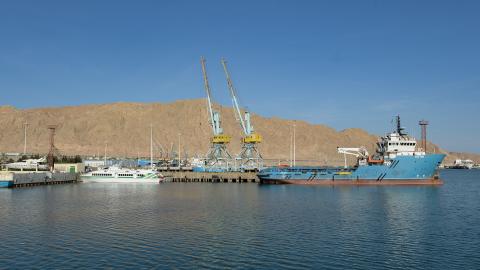The first pipeline connecting the Caspian Sea to the Black Sea opened in 1906. Stretching from Baku in Azerbaijan to Batumi in Georgia and originally carrying kerosene, it has since been replaced by a network of oil and gas pipelines that deliver energy resources to global markets.
However, one crucial piece has always been missing from this puzzle: a pipeline connecting the eastern shore of the Caspian Sea to its western side. This project may now finally be realized after decades of discussion.
Turkmen and Turkish officials agreed last week to drastically increase their gas trade volume over the next two decades, following an initial deal in March 2024 to boost energy cooperation.
To start, Turkmenistan will begin exporting 2 billion cubic meters of gas per year to Türkiye as part of a swap deal with Iran. In this arrangement, Turkmenistan sends gas to Iran, which then uses a different pipeline network to send the same amount of gas to Türkiye. However, both sides agree that a new pipeline will eventually be needed to increase gas trade. This is where the construction of a Trans-Caspian Pipeline comes in.
Both countries stand to benefit significantly from increased energy cooperation and the construction of a Trans-Caspian Pipeline to deliver gas to global markets. Turkmenistan is thought to have the world’s fourth-largest natural gas reserves, but it remains one of the poorest countries in the world. The continuing failure to diversify its economy, attract foreign investment, and seek new markets for its oil and gas has created a poor economic environment. A Trans-Caspian Pipeline and the foreign investment it would attract would be a step in the right direction to get the economy back on track.
Meanwhile Türkiye is striving to position itself as the region’s main energy hub. The gas deal with Turkmenistan, along with the construction of the infrastructure needed to bring Turkmen gas to Türkiye and then on to global markets, would solidify that goal.
The broader region would also benefit from a Trans-Caspian Pipeline. Since Russia’s invasion of Ukraine in February 2022, the EU has been seeking alternative sources for energy, particularly natural gas. There is already an agreement with Azerbaijan to double the amount of gas sent by Baku through the existing pipeline network to Europe by 2027. However, even this will not be enough to satisfy Europe’s growing energy needs. Direct access to Turkmen natural gas could play a significant role in improving the bloc’s energy security.
But the construction of a Trans-Caspian Pipeline is easier said than done. After all, discussions have been ongoing for decades, with no meaningful progress. Fortunately, the challenges are not technical. The distance between Turkmenistan and Azerbaijan is relatively short, and the depth of the pipeline would not be a major factor. Instead, geopolitical limitations have prevented construction.
As neighboring Caspian countries, Iran and Russia have blocked the project for years. Their official reasons are environmental, including the potential impact on the increasingly fragile Caspian ecosystem. However, the real motive is probably that neither country wants to compete with Turkmenistan’s gas exports.
Another challenge has been Turkmenistan’s reluctance to diversify its energy exports and attract the foreign investment needed for such a major pipeline project. Currently, almost all of Turkmenistan’s gas exports go to China. Despite the construction of a pipeline connecting major gas fields in Turkmenistan to the Caspian Sea, Ashgabat has been hesitant to push for the construction of a Trans-Caspian Pipeline.
A further challenge comes from Europe. While European politicians and officials frequently talk about seeking alternative energy resources away from Russia, they have been slow to sign the deals and contracts necessary to realize this goal. The EU needs to play a more active and direct role in the region and start signing contracts if it wants to see countries producing more energy to be exported to Europe.
Finally, there is the issue of capacity. The existing natural gas pipeline network, the Southern Gas Corridor, which connects Azerbaijan to Italy, will be at full capacity by 2027. Even if a Trans-Caspian Pipeline were constructed and completed, it is unclear how much additional gas could reach Europe. This means any discussion about constructing a Trans-Caspian Pipeline must also consider new infrastructure linking it to the rest of the world. While this may be a sizable challenge, it also creates an important opportunity.
For decades, Armenia has missed out on all regional energy and transport infrastructure projects because of tensions with Azerbaijan. However, with Armenian-Azerbaijani normalization looking closer than ever, there is an opportunity to help Armenia integrate into the regional energy and transport infrastructure for the first time in decades. Any new pipeline system should consider involving Armenia. Such an ambitious project could help integrate the region and build trust among old adversaries.
A pipeline is the only economically viable way to move natural gas across the Caspian Sea. Transporting it by ship as liquefied natural gas is not profitable over such a short distance. There is no better time to push for the construction of a Trans-Caspian Pipeline. Russia and Iran are less focused in the Caspian because of challenges elsewhere and Europe is in desperate need of new energy sources.
Turkmenistan and Türkiye, working with their regional partners, have an opportunity to re-shape the energy landscape on the Eurasian landmass. Time will tell if their talk will finally be turned into action.
Enjoyed this article? Subscribe to Hudson’s newsletters to stay up to date with our latest content.



















